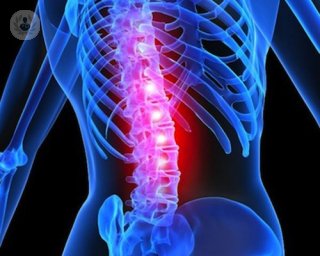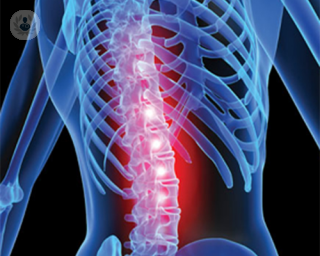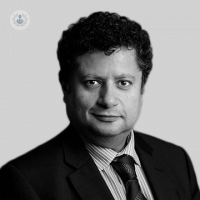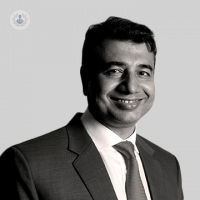What is minimally invasive spinal surgery?
Minimally invasive spine surgery, sometimes known as laparoscopic spine surgery, is an alternative to open surgery.
One of the biggest issues with spinal surgery is the multiple incisions that need to be made, which can lead to scarring and blood loss during the long procedure. With minimally invasive spinal surgery, the scars are smaller, damage to muscle mass is minimal, and the recovery time is much faster. The outcome is the same as with traditional surgery. For these reasons, minimally invasive spine surgery is opted for where possible.

Why would you have it?
It is crucial to personalise the treatment plan and take the patient’s medical history into account. Minimally invasive surgery has many advantages for the patient. It is normally recommended for:
- A neurological lesion
- Loss of strength
- Changes in sensitivity
- Severe pain that does not respond to treatment.
What does it involve?
During the surgery, a small 15mm incision will be made, which is where the cannula will be placed. Inside the cannula, there will be a camera that can magnify the area being operated on. This way, large incisions do not have to be made to be able to access the spine.
After the procedure, the patient will be kept in overnight to assess the results of the surgery. The patient will be discharged and can go home the next day.
Post-operative care
Upon being discharged, the patient can continue with their daily activities, within reason. The patient may have some discomfort, so exercise and impact sports should be avoided. Patients should follow the guidelines given to them, especially during the first few weeks. Between 6 to 12 weeks later, they can start exercising again. Short-term results are very good, and the patient can walk the day after surgery.
Alternative treatments
Minimally invasive spine surgery is a pioneering type of surgery within spinal surgery.
There are other kinds of surgery, such as open spine surgery, commonly used to get rid of back pain, especially when a slipped disc compresses a nerve root and all other non-surgical treatments have not provided relief. This technique is used when minimally invasive spine surgery is not an option.
There is another type of surgery called percutaneous spinal surgery. This technique involves making implants in the back with minimal incisions. It is done through a tube, slowly dilating the tissues, and placing the implant in the spine. This way there is no tissue damage, and the patient can walk away almost immediately.
11-13-2012 07-04-2024Minimally invasive spinal surgery
Mr Sean Molloy - Orthopaedic surgery
Created on: 11-13-2012
Updated on: 07-04-2024
Edited by: Carlota Pano
What is minimally invasive spinal surgery?
Minimally invasive spine surgery, sometimes known as laparoscopic spine surgery, is an alternative to open surgery.
One of the biggest issues with spinal surgery is the multiple incisions that need to be made, which can lead to scarring and blood loss during the long procedure. With minimally invasive spinal surgery, the scars are smaller, damage to muscle mass is minimal, and the recovery time is much faster. The outcome is the same as with traditional surgery. For these reasons, minimally invasive spine surgery is opted for where possible.

Why would you have it?
It is crucial to personalise the treatment plan and take the patient’s medical history into account. Minimally invasive surgery has many advantages for the patient. It is normally recommended for:
- A neurological lesion
- Loss of strength
- Changes in sensitivity
- Severe pain that does not respond to treatment.
What does it involve?
During the surgery, a small 15mm incision will be made, which is where the cannula will be placed. Inside the cannula, there will be a camera that can magnify the area being operated on. This way, large incisions do not have to be made to be able to access the spine.
After the procedure, the patient will be kept in overnight to assess the results of the surgery. The patient will be discharged and can go home the next day.
Post-operative care
Upon being discharged, the patient can continue with their daily activities, within reason. The patient may have some discomfort, so exercise and impact sports should be avoided. Patients should follow the guidelines given to them, especially during the first few weeks. Between 6 to 12 weeks later, they can start exercising again. Short-term results are very good, and the patient can walk the day after surgery.
Alternative treatments
Minimally invasive spine surgery is a pioneering type of surgery within spinal surgery.
There are other kinds of surgery, such as open spine surgery, commonly used to get rid of back pain, especially when a slipped disc compresses a nerve root and all other non-surgical treatments have not provided relief. This technique is used when minimally invasive spine surgery is not an option.
There is another type of surgery called percutaneous spinal surgery. This technique involves making implants in the back with minimal incisions. It is done through a tube, slowly dilating the tissues, and placing the implant in the spine. This way there is no tissue damage, and the patient can walk away almost immediately.


Dynamic spinal stabilisation: a new technique for reinforcing the spinal column
By Mr Mo Akmal
2024-11-20
Dynamic spinal stabilisation is a procedure used to reduce damage to a spinal cord or spinal roots, and there are a number of techniques used. Find out about the latest developments in this procedure, with our leading consultant orthopaedic surgeon, Mr Mo Akmal. See more


Open vs. minimally-invasive spinal surgery: which is better?
By Mr Richard Selway
2024-11-18
There are pros and cons to both open and minimally-invasive approaches, states Mr Richard Selway, a leading neurosurgeon at the London Neurosurgery Partnership. See more


Minimally invasive surgery - a safer technique for spine surgery
By Mr Sean Molloy
2024-11-18
Leading orthopaedic surgeon, and specialist in minimally invasive surgery Mr Sean Molloy, explains all about how minimally invasive surgery is an ideal technique. See more


Minimally invasive spine surgery: advantages and preparation
By Mrs Anne Mitchener
2024-11-16
If you're experiencing back issues you may have considered minimally invasive spine surgery as a solution. We found out from top neurosurgeon, Mr Anne Mitchener, what conditions this surgery treats, it's advantages and how patients should prepare for it. See more
Experts in Minimally invasive spinal surgery
-
Mr Sean Molloy
Orthopaedic surgeryExpert in:
- Minimally invasive spinal surgery
- Scoliosis
- Spine fracture
- Robotic surgery
- Spinal surgery
- Spinal fusion
-
Professor Keyoumars Ashkan
NeurosurgeryExpert in:
- Spinal surgery
- Brain tumour
- CyberKnife
- Deep brain stimulation (DBS)
- Minimally invasive spinal surgery
- Movement disorders
-
Mr Irfan Malik
NeurosurgeryExpert in:
- Spinal endoscopy
- Robotic spine surgery
- Spinal cancer
- Spinal surgery
- Minimally invasive spinal surgery
- Degenerative disc disease
-
Mr Nicholas Thomas
NeurosurgeryExpert in:
- Acoustic neuroma
- Acoustic neuroma surgery
- Endoscopic skull base surgery
- Minimally invasive spinal surgery
- Nervous system
- Transsphenoidal surgery
-
Mr Richard Gullan
NeurosurgeryExpert in:
- Spinal surgery
- Chiari malformations
- Brain tumour
- Minimally invasive spinal surgery
- See all

London Neurosurgery Partnership (HCA)
London Neurosurgery Partnership (HCA)
78 Harley St, London W1G 7HJ
No existe teléfono en el centro.
By using the telephone number provided by TOP DOCTORS, you automatically agree to let us use your phone number for statistical and commercial purposes. For further information, read our Privacy Policy
Top Doctors

Elstree Waterfront Outpatients Centre (HCA)
Elstree Waterfront Outpatients Centre (HCA)
Elstree Road, WD6 3BS
No existe teléfono en el centro.
By using the telephone number provided by TOP DOCTORS, you automatically agree to let us use your phone number for statistical and commercial purposes. For further information, read our Privacy Policy
Top Doctors

The London Independent Hospital - part of Circle Health Group
The London Independent Hospital - part of Circle Health Group
1 Beaumont Square, Stepney Green
No existe teléfono en el centro.
By using the telephone number provided by TOP DOCTORS, you automatically agree to let us use your phone number for statistical and commercial purposes. For further information, read our Privacy Policy
Top Doctors
-
London Neurosurgery Partnership (HCA)
78 Harley St, London W1G 7HJ, W1G Marylebone LondonExpert in:
- Minimal access surgery (keyhole surgery)
- Neurological spinal surgery
- Back pain
- Neurosurgery
- Brain and spinal tumours
-
Elstree Waterfront Outpatients Centre (HCA)
Elstree Road, WD6 3BS, ElstreeExpert in:
- Blood test
- Cardiology
- Dermatology
- Diagnostic Imaging
- Neurology
- Paediatrics
-
The London Independent Hospital - part of Circle Health Group
1 Beaumont Square, Stepney Green, East LondonExpert in:
- Cataracts
- Bariatric Surgery
- Maxillofacial Surgery
- Neurological spinal surgery
- Orthopaedic surgery
- Orthopaedic spinal surgery
- See all
- Most viewed diseases, medical tests, and treatments
- Migraine
- Joint pain
- Lumbar herniated disc
- Abdominal pain
- Spinal surgery
- Minimal access surgery (keyhole surgery)
- Shoulder pain
- Tremor
- Seizures
- Parkinson's disease







